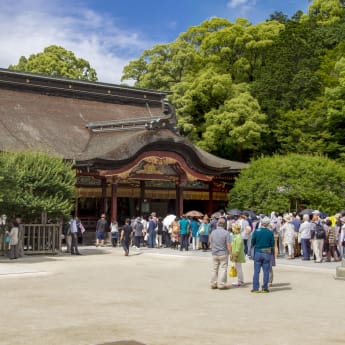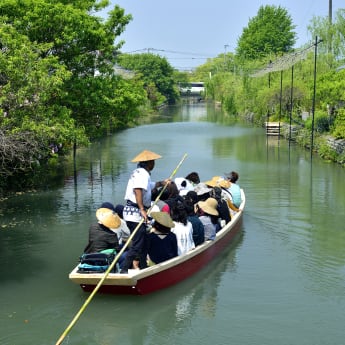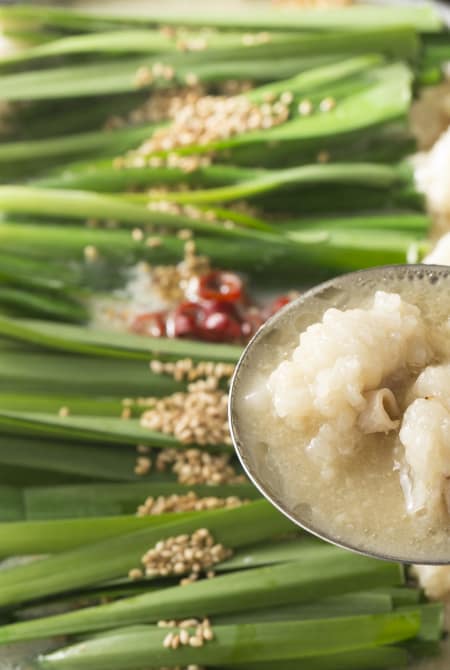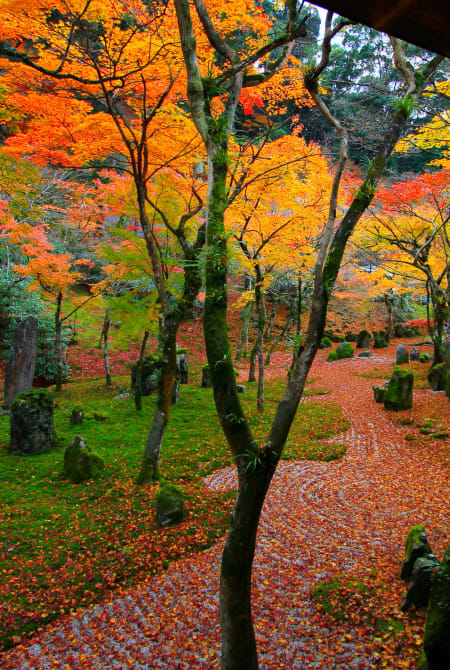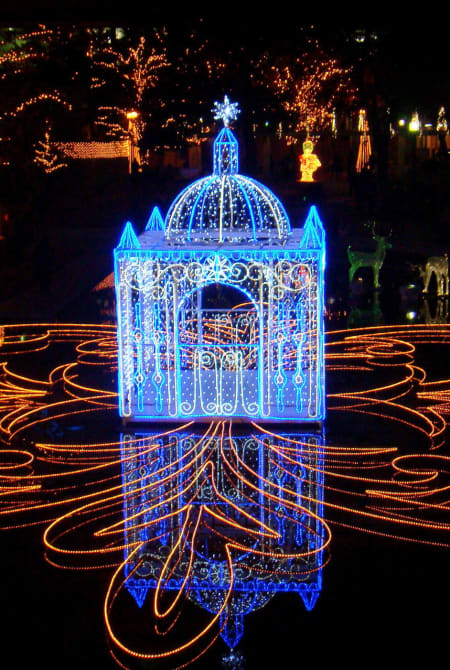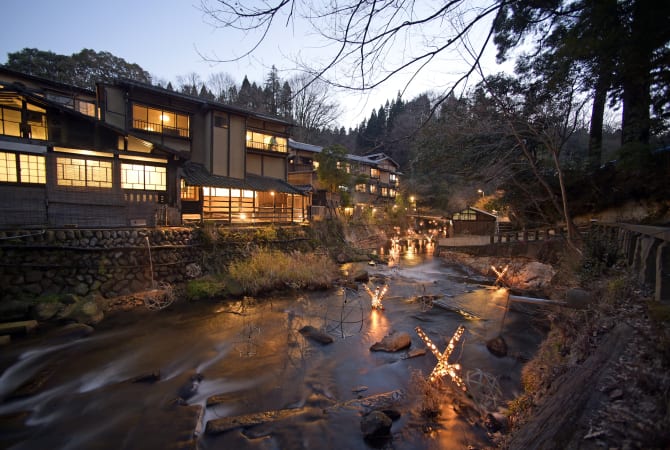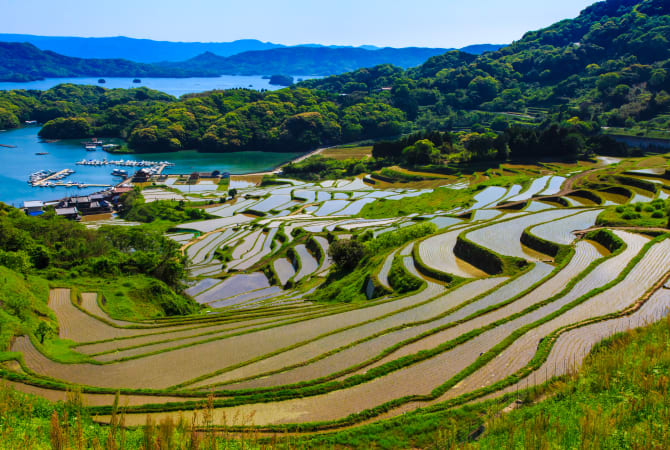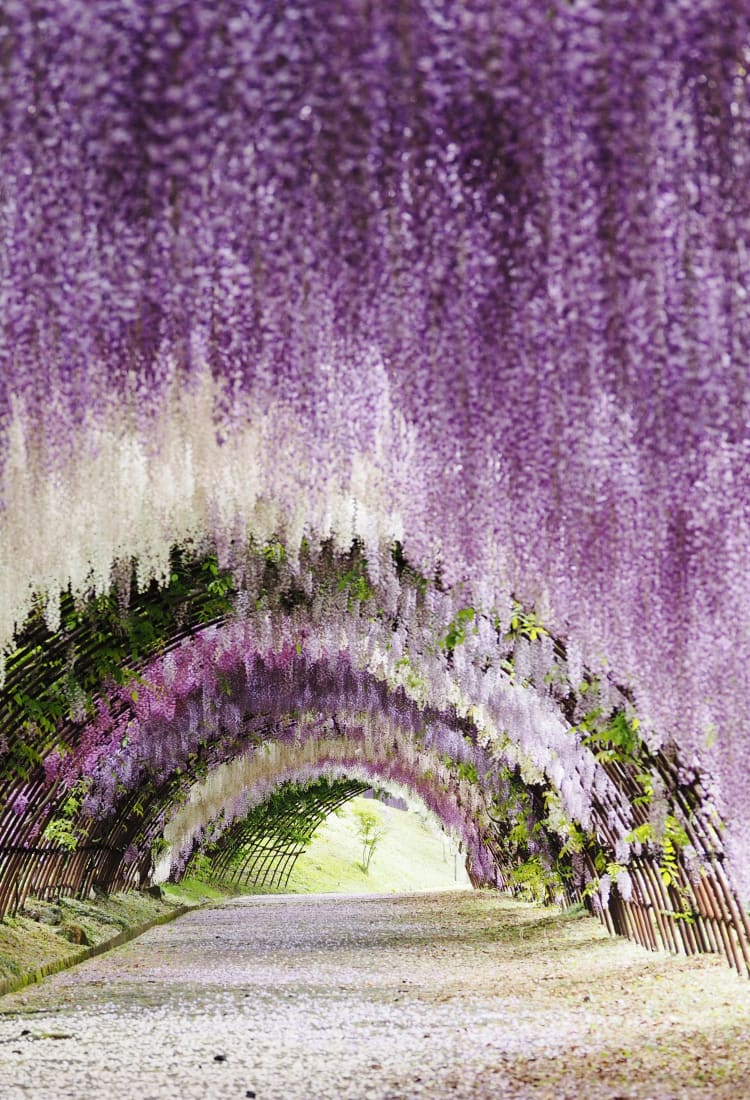

Kyushu Fukuoka Ein wissenschaftlicher Schrein und Ramen am Meer
Entdecken Sie eine Küste, die für den Wassersport geschaffen ist, ein gebirgiges Hinterland voll verschlungener Pfade, erstklassige Meeresfrüchte und Ramen
Die berühmteste Attraktion der Präfektur Fukuoka ist Dazaifu Tenman-gu, ein Schrein, der dem historischen Gelehrten und Politiker Sugawara no Michizane gewidmet ist und über 6000 Pflaumenbäume beherbergt, die jedes Frühjahr spektakulär blühen. Zu den kulinarischen Spezialitäten der Präfektur gehören Sushi und andere Meeresfrüchte, Yakitori (gegrillte Spieße), der Innereien-Eintopf Motsunabe im Winter und Tonkotsu-Ramen (Schweinebrühe), die man am besten an einem lokalen Yatai (mobile Garküche) zu sich nimmt. Fukuoka liegt an der Nordspitze von Kyushu und ist dank ausgezeichneter Verkehrsanbindung gut zu erreichen.
Anfahrt
Fukuoka ist per Bahn oder Flugzeug gut erreichbar. Die Präfektur hat zahlreiche Haltestellen sowohl auf der Linie Shinkansen JR Kyushu als auch auf der Linie Shinkansen JR Sanyo, die nach Hiroshima, Osaka, Kyoto und Tokyo führt. Der Flughafen Fukuoka liegt sehr nah am Stadtzentrum. Von Hakata, dem Hafen der Stadt Fukuoka, gehen Fähren nach Südkorea und zu vielen der kleineren Inseln von Kyushu.
Die Stadt Fukuoka ist das wichtigste Verkehrszentrum der Präfektur. Von hier aus können Sie problemlos mit dem Zug, Bus oder einer Fähre die restliche Präfektur bereisen oder weitere Orte in Kyushu erreichen. Der Bahnhof Hakata in der Stadt Fukuoka ist der Eisenbahnknotenpunkt der Präfektur, Endstation der Shinkansen-Linien Sanyo und Kyushu. Von Hiroshima nach Fukuoka brauchen Sie mit dem Shinkansen eine Stunde, von Nagasaki sind es mit dem Zug etwa zwei Stunden. Wenn sie von Tokyo nach Fukuoka reisen möchten, brauchen Sie mit dem Flugzeug zwei oder mit dem Shinkansen fünf Stunden. Fukuoka ist von ganz Asien aus mit internationalen Flügen gut erreichbar.
Nicht verpassen
- Die jährliche Pflaumenblüte am Tenmangu-Schrein von Dazaifu
- Ein Blumenbogen aus Glyzinien im Garten Kawachi Fuji-en in Kitakyushu
- Die Küste der Halbinsel Itoshima: Sandstrände, Musikfestivals und eine aktive Surfszene
- Luxuriöse Bootstouren durch die Kanäle von Yanagawa und Gerichte mit frischem Aal
Sehenswürdigkeiten Fukuoka nach Bereich
angesagte Attraktionen in Fukuoka
Lokale Spezialitäten
-
Amaou-Erdbeeren
Amaou ist eine Erdbeersorte, die in Japan für ihren intensiven, süßen Geschmack bekannt ist. Der Name kombiniert die japanischen Wörter für rot, rund, groß und schmackhaft. Amaou-Erdbeeren werden auch für die Herstellung von Likör, Marmelade und Süßigkeiten verwendet.

-
Yame-Tee
Die Yame-Region in Fukuoka bietet ideale Bedingungen für den Anbau von grünem Tee. Die Teeanbauer produzieren seit 600 Jahren hervorragenden grünen Tee mit überlieferten Techniken. Es lassen sich auch Produkte finden, die der Gesundheit dienen und Honig mit Matcha-Teepulver kombinieren.

-
Gebackenes Curry
Ein beliebtes Fukuoka-Komfortgericht, ähnlich einem Auflauf oder einem Gratin. Reis, kräftiges japanisches Curry, Käse und ein rohes Ei werden in eine Backform geschichtet und gebacken. Das Gericht ist sehr nahrhaft und wärmt von innen.

-
Hakata als bissgroße Gyoza
Hitokuchi gyoza unterscheiden sich nicht sehr von normale Teigtaschen, sie sind nur kleiner. Sie werden mit Hackfleisch und Knoblauch gefüllt, außen knusprig gebraten und sind innen zart. Da sie jedoch kleiner sind als die üblichen Teigtaschen, werden in der Regel mehr von ihnen gegessen.

-
Fukuoka Motsu Nabe
Die Köche in Fukuoka haben das Kochen mit Rind- und Schweinefleisch zu einer Kunst erhoben. Motsu nabe ist ein Feuertopfgericht mit Kutteln, das all diese Vorzüge in einer köstlichen Suppe aus Sojasauce und Knoblauch vereint.

-
Mizutaki
Mizutaki ist ein Feuertopfgericht, das aus Hühnerteilen mit Saisongemüse in einer Hühnerbrühe gekocht und dann mit Ponzu, einer Sauce auf Zitrusbasis, serviert wird. Es heißt, es sei in Fukuoka um die Mitte des späten 19. Jahrhunderts entstanden.

-
Yakitori
Yakitori sind typische Spieße aus saftigem Hühnerfleisch, oft mit Gemüse vermischt und über einer offenen Flamme gegrillt. Sie sind ein sehr beliebtes Gericht in Fukuoka. In Kurume findet jedes Jahr im Oktober ein Festival statt, das den Yakitori gewidmet ist. Passt hervorragend zu Bier.

-
Tonkotsu Ramen
Tonkotsu Ramen, eine der weltweit bekanntesten Ramenarten, zeichnet sich durch seine trübe Schweineknochenbrühe, dicke Scheiben aus Schweinefleisch, dünne Nudeln und wenige Beilagen aus. In Fukuoka, dem Geburtsort von Tonkotsu, ist das Gericht überall zu finden – in Spezialitätenrestaurants, Restaurants für ein spätes Abendessen, bei Straßenverkäufern und sogar auf Bahnhöfen.

-
Kurume-Stoffe
Kurume kasuri ist ein Baumwollgewebe, das im Sommer kühl und im Winter warm ist und durch das Tragen noch bequemer wird. Hergestellt aus widerstandsfähig gefärbtem Indigofaden, verwandeln die eingewebten spektakulären Muster und Bilddesigns den Stoff in ein Kunstwerk.

-
Koishiwara-Waren
Stilvoll und einfach – Koishiwara yaki bezieht seinen Charme aus den auffälligen Mustern, die Handwerker durch geschicktes Stanzen, Glätten und Bemalen der fertigen Tonform erzielen. Diese ungezwungene und dennoch elegante Keramik ist perfekt für Alltagsgeschirr und als Dekor für Wohnräume. Solche Töpfer-Schmuckstücke lassen sich am besten dort finden, wo sie hergestellt werden, z. B. in dem Dorf Toho.

-
Hakata-Stoffe
Im Bezirk Hakata von Fukuoka sind die chinesischen Webtechniken des Hakata ori zu Hause, die hier bereits im frühen 13. Jahrhundert angesiedelt wurden. Dieser gefärbte Brokat, leicht zu binden und zu schließen, eignet sich perfekt für Obi-Schärpen. Samurai haben damit ihren Kimono gebunden und ihre Schwertscheiden gesichert. Heutzutage wird Hakata ori beispielsweise bei Kartenetuis, Geldbörsen und anderen Souvenirartikeln verwendet.

-
Hakata-Puppen
Die Geschichte von Hakata ningyo umfasst folkloristische Erzählungen, archäologische Artefakte und Berichte über Präsentationen auf Ausstellungen wie der Pariser Weltausstellung 1900. Diese handbemalten Tonpuppen werden in einer Fülle traditioneller Charaktere hergestellt, von schönen Damen in Kimonos bis zu massigen Sumoringern.

Saisonale Highlights
-
Frühjahr
Der Tenmangu-Schrein von Dazaifu ist Schauplatz von Japans spektakulärster Pflaumenblüte an 6000 Bäumen. Bald folgen auch Kirschblüten und Tulpen und machen die gesamte Präfektur zum Blütenmeer.

-
Sommer
Die Einheimischen fahren an die Strände der Halbinsel Itoshima zum Grillen oder in die Berge, um die kühlere Höhenluft zu genießen. Essen Sie an einer Yatai, der traditionellen mobilen Garküche.

-
Herbst
Wenn sich Fukuoka und das Laub auf dem Berg Hiko in Herbstfarben hüllen, ist das Wetter besonders angenehm. Die kleine Insel Nokonoshima ist besonders bekannt für ihre zahlreichen Kosmeen-Blüten.

-
Winter
Freuen Sie sich auf eine dampfende Schüssel Motsunabe, den ortstypischen Innereieneintopf, der den Körper gut durchwärmt. Fahren Sie – gewärmt von einer beheizten Kotatsu-Decke – durch die Kanäle von Yanagawa oder probieren Sie Winteraustern in Itoshima.












































